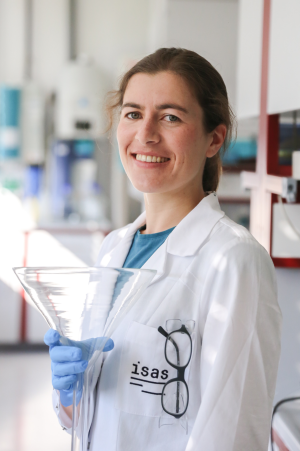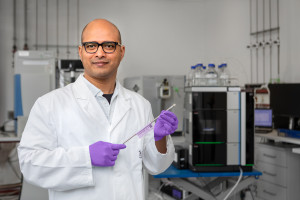Dortmund, 9th September 2021
Mona Ehlers discovered her spirit of research at an early age. That is why she moved from Lower Saxony to Münster to become a student of food chemistry in 2010. During her doctorate in Berlin, she used instrumental analytics to analyse the different components of wine. She was able to detect whether it had been adulterated, for example. As she wants to contribute to the human health with her research, she came to ISAS in May 2021.
Since then, Ehlers has been working in the Proteomics group. The 30-year-old is part of the joint project NephrESA which aims to improve the treatment of anaemia in patients with chronic kidney disease.
Omics technologies - seeing the big picture
Due to chronic disease, many patients' kidneys do not produce enough of the hormone erythropoietin (Epo) for normal blood formation. To treat this renal anaemia, they receive Epo or other so-called erythropoiesis stimulators (ESA). Ehlers is looking into the highly increased risk of thrombosis, that often occurs with this drug treatment. She is working on analytical methods in order to identify which proteins change in the blood under drug treatment. As a result, the risks and prognoses of the medication could be determined individually for those affected in the future. For her method, Ehlers uses so-called omics technologies. They are characterised by a combined approach that makes it possible to obtain data from several molecular levels and depict a holistic picture of one sample. "The analyses are similar to the once I used before. Only now I'm examining blood plasma instead of red wine," explains Ehlers. Around 300 patient samples, provided by the project partner, the University Medical Center Hamburg-Eppendorf (UKE), are already waiting at minus 80 degrees Celsius in the ISAS' freezer to be examined. The chemist wants to use the data to find out how the increased risk of thrombosis can be recognised and treated at an early stage.
Currently only digital
The five sub-projects of NephrESA have each specialised in one area, however they regularly discuss their findings. "Due to the pandemic, our exchange has of course only been possible online or on the phone so far. That's sometimes difficult because we can't show each other the procedures in our labs," says Ehlers. That is why the scientist is looking forward to meeting the other project partners in person as soon as possible. When the pandemic is over, she would also like to pursue two of her hobbies which she was last able to do whilst living in the capital: Singing in a choir and dancing Lindy Hop.
(Cheyenne Peters)

Mona Ehlers' research at ISAS aims to improve the treatment of anaemia in patients with chronic kidney disease.
© ISAS
What are Omics Technologies?
The term omics is used in research to describe molecular biological methods, for example genomics, lipidomics, metabolomics or proteomics, with which biomolecules from tissue samples or other biological samples can be examined on a global level. Omics technologies are an important starting point in personalised medicine, as they produce large amounts of data that provide information about disease processes and possible therapeutic approaches.








